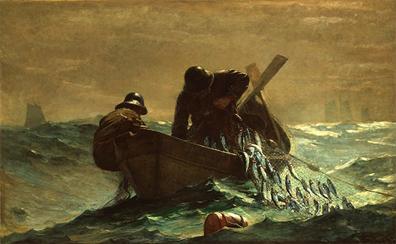|
Posted: 10 Feb 2012 02:31 PM PST
Artists by nature tend to be rebels, especially against rules. Some have even created art movements by defying conventional rules. We need only glance back to the mid-19th century to find in the Impressionists the most scandalous rule-breakers in art history. They radically disobeyed the conventional rules of their time and eventually became the heroes of our day. But it was conventions they rebelled against, not composition principles.
There is a difference between conventional rules and principles of composition. A conventional rule is an accepted guideline set forth by agreement among artists, but a principle of composition is a functioning law of physics that gives an art work order so that it can be read without confusion.
Another method for defying the convention of "never center" is to use radial balance where elements circle around a central area. Henri Matisse used this principle in his painting, "Dance I" and Albrecht Durer used it in his etching, "The Lamentation"One of these conventions that is not itself a principle tells us never to place an area of interest in the center of a painting. This convention can be successfully defied by an artist who understands the principle of balance. Balance is a law of the physics with respect to equilibrium: elements visually heavier on one side will overpower lighter weighted elements on the other. One way to defy the "never center" convention is to use symmetrical balance which makes one side of an art work a mirror image of the other. Painter Georgia O'Keefe employed this principle in her painting, "Cow's Skull: Red, White and Blue" and Leonardo da Vinci used in in his "The Last Supper."
|
Add a Comment
-
Comment by Jim Moyer on February 23, 2012 at 1:43
-
I worked on a boat scene from Peggy’s cove yesterday and placed the boat above center, However when I added the boats reflection it ended up dead center + o r – I will try lots of lead-ins to fix I will post in a few days.
-
Comment by Eddie Morris on February 22, 2012 at 17:45
-
Thanks Jim.
-
Comment by Julie Wickham on February 12, 2012 at 19:43
-
Great article - thanks Jim - there is so much to consider when planning a painting - this is a fantastic summary of just element.
-
Comment by debbie piro on February 12, 2012 at 13:35
-
Jim, Thank you, this helps with understanding a few things..
-
Comment by Montalvo on February 12, 2012 at 7:22
-
Jim,"Thank you" for posting. This was something i was wondering about. I usually paint without giving thought to the composition. I still have much more to learn. Thank You.
© 2024 Created by Richard Robinson.
Powered by
![]()






You need to be a member of The Complete Artist to add comments!
Join The Complete Artist